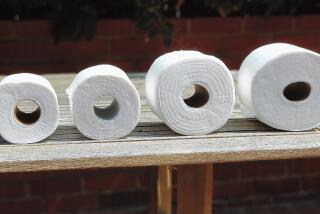China becoming mighty oak of world’s paper industry
- Share via
JIN JILING, China — In silent, temperature-controlled labs in a desolate part of Hainan, China’s most tropical province, rows of women in medical masks and lab coats clone trees that grow freakishly fast.
The trees have official names, such as APP-22 or DH32-29, but Wending Huang, Asia Pulp & Paper Co.’s chief forester in China, calls them his “Yao Mings” after the towering Chinese basketball star. The tiny green tissue samples, methodically implanted in petri jars, will become hardwood eucalyptus trees that need only four to six years to reach full height, up to 90 feet or more.
The test-tube forests have helped undo the long-standing natural advantage of papermaking states such as Wisconsin, where hardwood trees are plentiful but can take up to 10 times as long to reach harvesting height.
What’s more, boosted by billions in government subsidies, China has been building massive new mills with automated machines that can produce a mile of glossy publishing-grade paper a minute.
Over the course of the last decade, China tripled its paper production and in 2009 overtook the United States as the world’s biggest papermaker. It can now match the annual output of Wisconsin, America’s top papermaking state, in the span of three weeks.
China also created the world’s biggest and most efficient paper recycling scheme. It now buys about 27 million tons of scrap paper and used cardboard from around the world each year, then de-inks and re-pulps it for about two-thirds of its own paper and cardboard production.
But that is still not enough — for China’s needs or its ambition.
China imports the vast majority of virgin timber and processed pulp from around the world — 14.5 million tons last year from places like Russia, Indonesia and Vietnam. That has earned the ire of environmental groups, which say China’s insatiable appetite for wood pulp is destroying the world’s forests. It has drawn the fire of politicians who accuse China of unfairly subsidizing its mills and dumping paper on the U.S. market, putting domestic operations out of business and an entire industry at risk.
With 20 modern mega-mills spread across China, Indonesia-based Asia Pulp & Paper is at the center of the accusations.
It is an unusual place to find a guy from Wisconsin.
Jeff Lindsay, 52, is a 20-year veteran of that state’s paper industry who was recruited by Asia Pulp & Paper in 2011 to run its growing portfolio of patents.
He holds a doctorate in chemical engineering, was on the faculty of the now-defunct Institute of Paper Chemistry in Appleton, Wis., and later joined Kimberly-Clark Corp., which gave the world Kleenex. He holds 130 patents and co-authored a 2009 book, “Conquering Innovation Fatigue,” which took aim at barriers to U.S. innovation.
He noted that paper was invented in China (AD 105) and remains a potent national symbol. It is taught in Chinese classrooms as one of the four “great inventions,” along with the compass (200 BC), gunpowder (AD 850) and printing presses with movable type (1313).
“These inventions came from China,” Lindsay said. “When people go pointing their finger at the Chinese paper industry or saying we shouldn’t be buying paper from China — paper came from China.”
The West, he says, is in denial about the competitive edge offered by Chinese science, engineering and ingenuity. “You have to innovate to survive in this world,” he said.
A heavy infusion of government money helped fund innovation. The Washington-based Economic Policy Institute estimates that the Chinese government doled out at least $33 billion in subsidies to its paper industry from 2002 to 2009 — the period that coincides with its stunning growth.
Schmid writes for the Milwaukee Journal Sentinel. Emily Yount contributed to this report.
More to Read
Inside the business of entertainment
The Wide Shot brings you news, analysis and insights on everything from streaming wars to production — and what it all means for the future.
You may occasionally receive promotional content from the Los Angeles Times.










